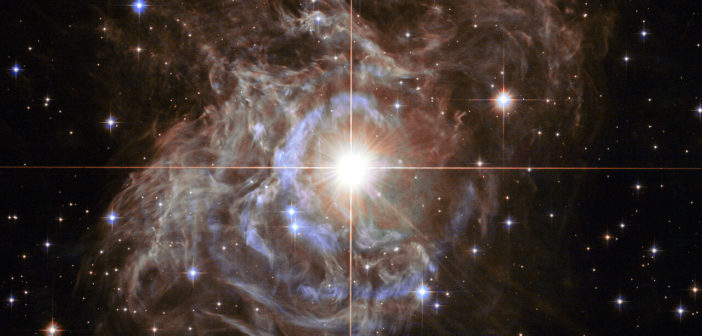Cepheids are pulsating variable stars, meaning that their periodic changes in brightness are associated with changes in physical size. The wavelengths at which Cepheids emit radiation also vary as the stars pulsate. So what’s happening in the X-ray when it comes to Cepheids?
Classical Cepheids and Modern Observations

X-ray images of the Cepheid δ Cephei and a non-varying nearby star. The variability of δ Cephei is evident from the two images. [NASA]
In short, a Cepheid’s period is related to its brightness in a well-defined way, and we can use that knowledge to determine how far away a given Cepheid is if we measure its period. This property of Cepheids has made them critical to measuring large distances in space, which are extremely valuable in astronomy. So, it’s important that we understand Cepheid behavior very well.
Cepheid emission at shorter wavelengths (e.g., ultraviolet, X-ray) is strong when Cepheids are at their smallest. However, observations taken over the last few years have shown that Cepheids have an unexpected increase in X-ray emission when they’re at their largest.
Shocks in Cepheid atmospheres could be behind this surprise X-ray emission. As Cepheids pulsate, their layers can bump against each other, sending shock waves outward into the stars’ atmospheres. There, the shocks could heat the plasma, causing emission at X-ray wavelengths. To explore the possibility of shocks causing X-ray emission, a group of researchers led by Sofia-Paraskevi Moschou (Center for Astrophysics | Harvard & Smithsonian) simulated Cepheids along with the spectra that would be observed from those simulated stars.

X-ray light curves from three of the Cepheid simulations. The dashed lines indicate one-fourth of the maximum brightness for a given simulation. [Adapted from Moschou et al. 2020]
Shocking Details
Cepheids contain complex environments. Aside from pulsation and shocks, they also experience mass loss driven by winds and magnetic fields. Density and temperature can vary throughout a Cepheid, to say nothing of how radiation permeates through the star.
To account for all these complexities, Moschou and collaborators used modeling software that could simulate Cepheid properties in great detail. They based their simulations on the prototype Cepheid, δ Cephei, which is five times more massive than the Sun. After simulating Cepheids assuming different underlying conditions, Moschou and collaborators then used their results to create corresponding X-ray spectra and light curves.
Shocks for Shorter Periods
It turns out that shocks can produce the observed X-ray emission! However, the varying X-ray emission throughout the Cepheid pulsation cycle suggests that the emission at maximum radius is caused by shocks, while the emission at minimum radius is from another, more consistent process.
δ Cephei is a short-period Cepheid as Cepheids go, so the mechanisms in longer-period Cepheids may present different challenges. As is typical with astronomy, more observations will definitely come in handy!
Citation
“Phase-modulated X-Ray Emission from Cepheids due to Pulsation-driven Shocks,” Sofia-Paraskevi Moschou et al 2020 ApJ 900 157 doi:10.3847/1538-4357/aba8fa


1 Comment
Pingback: From AAS NOVA: “Seeing Cepheids in the X-Ray” | sciencesprings